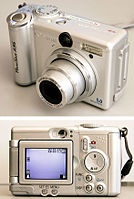
Photo from wikipedia
Imaging and brain stimulation studies seem to correct the classical understanding of how brain networks, rather than contralateral focal areas, control the generation of unimanual voluntary force. However, the scaling… Click to show full abstract
Imaging and brain stimulation studies seem to correct the classical understanding of how brain networks, rather than contralateral focal areas, control the generation of unimanual voluntary force. However, the scaling and hemispheric-specificity of network activation remain less understood. Using fMRI, we examined the effects of parametrically increasing right-handgrip force on activation and functional connectivity among the sensorimotor network bilaterally with 25%, 50%, and 75% maximal voluntary contractions (MVC). High force (75% MVC) unimanual handgrip contractions resulted in greater ipsilateral motor activation and functional connectivity with the contralateral hemisphere compared to a low force 25% MVC condition. The ipsilateral motor cortex activation and network strength correlated with relative handgrip force (% MVC). Increases in unimanual handgrip force resulted in greater ipsilateral sensorimotor activation and greater functional connectivity between hemispheres within the sensorimotor network.
Journal Title: Neuroscience
Year Published: 2021
Link to full text (if available)
Share on Social Media: Sign Up to like & get
recommendations!